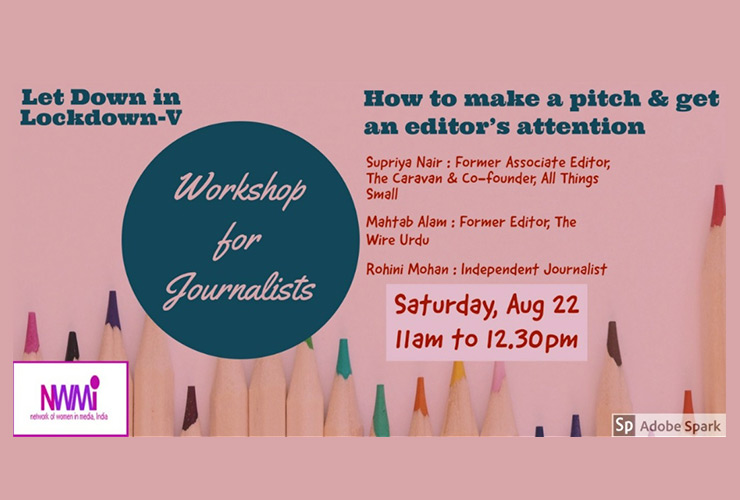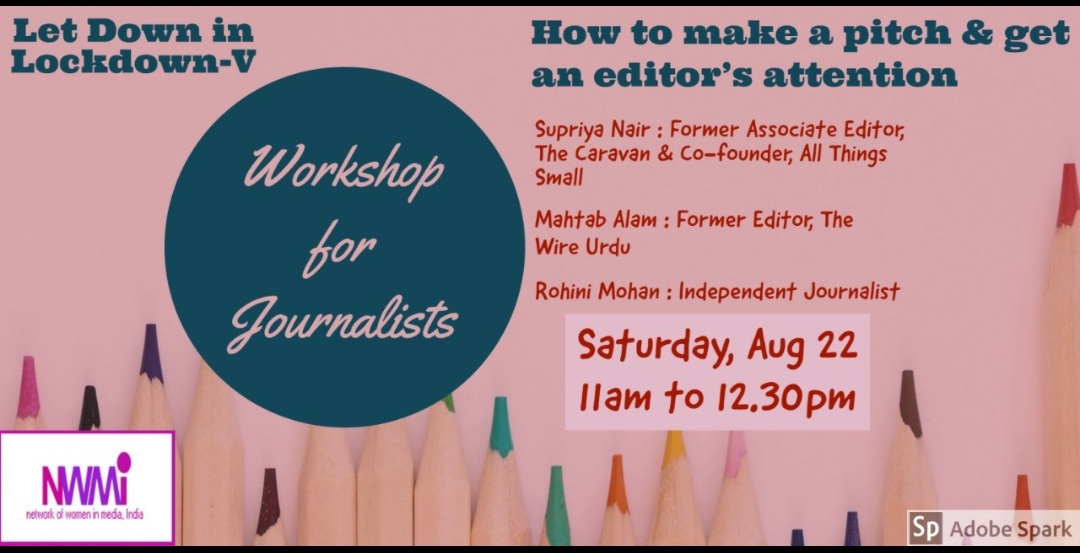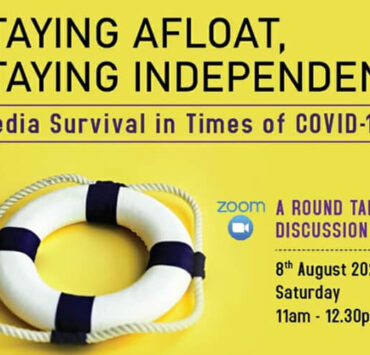
By Supriya Unni Nair

22 August 2020
The fifth NWMI webinar in the Let down in Lockdown series took place on August 22, 2020 in the form of a workshop for freelance journalists on how to pitch to editors. The panelists shared valuable tips and guidelines based on their experience on how to pitch correctly to an editor as freelance writer.
Panelists: Supriya Nair, former associate editor, The Caravan; co-founder, All Things Small; Mahtab Alam, former editor, The Wire Urdu; Rohini Mohan, independent journalist
Reaching out: How to get a conversation started
Supriya Nair began the session by pointing out the importance of building a relationship with the commissioning editor, focusing primarily on ‘selling your story’.
Pitches are essentially action-oriented emails, she said, aiming to catch the attention of the editor and make him or her respond. It is essential to have a story in mind when writing to an editor since a generic pitch is unlikely to be successful. She pointed out that, in India, there are more writers than space to be filled, so it is crucial for a freelancer to make his or her pitch stand out enough to get the editor’s attention. A key factor for this is to figure out who your target audience is and get to know a bit about your editor.
According to her, getting familiar with the style of the publication is important to help hone a pitch. Such background work will help avoid pitching stories that have been covered before. The writer should give the impression that he or she is a consumer/reader of that particular publication, she said.
A writer may reach out to editors on social media, she said, but he or she should never give away the subject matter of the pitch there. If the writer doesn’t know a commissioning editor’s personal email id, he or she can reach out on the general email contacts of the publication, and asked to be put on to the concerned commissioning editor.
Supriya warned that a pitch should always be about a story but never the actual, completed story. Editors do not have the time to read through a whole story written before it has been commissioned, and most would want to be involved in the development of the story.
According to her, a writer should never be afraid of sounding confident about themselves and their stories. She was of the opinion that most editors do not like to second guess, so it is essential to eliminate as much doubt as possible at the pitch stage.
A good pitch should include the proposed story’s topicality and relevance, and make a case for why the writer wishes to undertake the assignment. The writer should also explain why he or she is pitching to that particular publication, and the suitability and relevance of the story to it.
Supriya suggested that a pitch should never include the writer’s detailed resume. Pitch-emails to editors should include a final paragraph on the writer, providing information about social media accounts and blogs (if any).
Supriya shared a comprehensive handout she had put together on various aspects of pitching from an editor’s point of view, which can be accessed here.
Simple formula for a pitch
Independent journalist Rohini Mohan explained that it is essential to keep the pitch brief, but underlines that a section of it should be detailed enough so that it is easily ‘transplantable’ to the editorial meeting. Even if a writer is pitching to an editor he or she knows, this section should be clear enough so that anyone who reads it will understand the proposed story. However, she warned that writer should never disclose the whole story.
Rohini also pointed out that editors are normally always pressed for time, so it is crucial to grab their attention.
A good pitch needs a strong news peg, she said, and should underline the scope of a story. The writer has to convince the editor of the ‘uniqueness’ of that particular story, outline a reporting plan and explain why he or she would be the best person to cover it. This information can include: Location – where the writer stays and whether he or she would be travelling to a specific location to cover the story; Languages that the writer knows and how this may help in covering the story; Background – brief mention of the writer’s body of work.
Rohini advised writers to never specify a deadline in their pitches as most editors would prefer giving their own deadline specifications. She said that the writer should instead lay down a possible timeline for the work to indicate the likely amount of time required.
She said a good pitch must also explain why the story would be of interest to the editor and the publication (and its readers), but stressed that, at the end of the day, the editor must feel he or she is the boss.
She also suggested that the writer should also never specify the word limit in the pitch since that would be the editor’s call. Including too many statistics is also a ‘no’, she added.
Video stories
According to Rohini, pitching for video stories follows the same pattern as that for print, but it is imperative in this case to be even more to the point, and to keep the pitch as brief as possible.
Rohini shared a detailed PPT, with examples of pitches that were accepted and rejected.
The document can be accessed here
Freelancing for regional publications
Mahtab Alam approached the topic from the perspective of Indian language publications, especially the Hindi and Urdu media that he is most familiar with.
He was of the opinion that language really does not make much difference when it comes to the basic principles that freelancers should follow. He explained that the specific publication is what matters most. Writers should do their homework thoroughly on who they wish to write for and who their target audience is. He pointed out that for this, it is imperative for the writer to be familiar with the publication her or she is pitching to and to find out what kind of stories they usually carry, what their particular focus is.
Most writers feel their story is of utmost importance, but it is not necessary that the editor should feel the same way. Identifying a ‘thrust area’ or focus area is one of the first steps required before pitching a story, he explained.
Mahtab advised that unless a writer has contacts and connections at the ground level, it is unadvisable to pitch for stories that require ground reporting.
Another important factor is the medium the writer chooses to pitch to. He explained that, nowadays, newspapers do not offer much scope for freelancers, though the supplements do take some freelance contributions. He also pointed out that some digital platforms showcase both video and text-based stories. Pitching for both will ensure more income, he suggested.
Mahtab suggested that in a pitch email the editor’s attention should be grabbed even through the subject line. Using questions in the subject line can help heighten interest, he said.
For those pitching for the first time to a particular editor, it is crucial to explain why they should choose you to write a particular story. Writers should introduce themselves, underlying skills such as being multi-lingual.
Contextualizing the story is essential to a pitch being acceptable, he explained. A pitch needs to be brief and to the point. According to him, in some cases, especially in regional language media, the publication may be short staffed, with many people multi-tasking. So it is essential that pitches be short and clear.
The writer should also underline when he or she will be able to deliver the story if the pitch is accepted.
Mahtab advised debutant writers never to pitch stories that could lose relevance in a short time. Such topical/time-sensitive stories should be pitched only after establishing a relationship with the editor.
Talking to sources before pitching
According to Rohini Mohan, speaking to key players in a story is part of pre-pitching research. This is how the scope of the story is explored. However, she added, not all stories require this at the same level, she added. If a particular source has provided unique information, it is imperative to get his or her permission before sharing it, she said, while clarifying that experts, government sources, and others providing general information do not need to be asked before a story is pitched.
Supriya Nair also emphasised that the degree to which the source’s information is relevant to the pitch is very important. If a peg depends on that, the writer must speak with the source, get permission to pitch and inform the editor that the writer has the necessary access to the source to write the story, she said.
Whether or not to tell editors that you have pitched to someone else
Supriya Nair was of the opinion that a writer should be honest and disclose that they had pitched to someone else even if the pitch was rejected. She pointed out that the community of editors in India is small, and it was inevitable that one editor would come to know from another if a particular writer had pitched or written a story. From the point of view of an editor, it is better if a writer is upfront, she said. On the whole, Supriya was not in favour of simultaneous pitching, as it may ruin your relationship with the editor.
However, Mahtab Alama and Rohini Mohan believed that it was better not to disclose such details to a commissioning editor. According to Rohini Mohan, a writer should not disclose who they were pitching to, and should definitely never disclose that the story was a ‘reject’. It is important to be strategic in conveying that kind of information, she said.
Mahtab suggested that a writer should not share such information, but should always make it clear that he or she is ready to rework a story.
Rohini summed up the debate saying that it depends on the editor – some prefer honesty, while some may not take kindly to the idea of the writer pitching the story to multiple people.
Follow up to a pitch
Mahtab Alam explained that there could be many reasons for a delay in response. Apart from the obvious reason that the editor may be busy, there could other reasons for the delay. For example, mails sent may have gone into the spam folder.
He suggested that a 24-hour gap be given to editors before sending a reminder. He warned against pestering editors on whatsapp and via phone calls, as sometimes the writer’s excitement may translate into irritation for the editor. He also explained that the day the email is sent also determines when a writer will hear from an editor. If an email is sent on Friday, a response can be expected only by Monday afternoon at the earliest. Mahtab also pointed out that, in some cases, editors may use the story much later.
Drawing from her own experience, Rohini Mohan said that, normally, if she doesn’t hear from an editor within two or three days, she moves on. She calls up editors only about payment.
Supriya Nair said that the timeline for follow ups depends on whether the story is a news story or a feature. She advised that it is essential to give a story the time it needs. For features, she suggested waiting for four days. On an average a week to ten days is acceptable, she said. It should be adequate to send two follow ups in two weeks, she added.
Expenses
Supriya Nair explained that once a story is accepted by the editor, the writer has more power to ‘bargain’. A good editor will always tell you upfront how much they will pay for a story.
Rohini Mohan revealed that she usually discusses payment before she starts working on the story angle and so on. She suggests that writers should factor in their travel and other expenses into what they are asking for. She underlined that it is a writer’s right to ask for payment, and that freelancers should not shy away from talking about money.
Mahtab Alam cautioned that it would be difficult for a beginner to bargain with editors about money. However, he added that the journalist should not hesitate to discuss and ask for payment.
Advice to debutant writers and those with no journalism background
Supriya Nair advised all debutant writers to showcase their writing in personal blogs and other social media platforms. She suggested writing a newsletter as an effective way to build up a bank of writing that can be shared. She said it was essential for writers to build a community around themselves.
Mahtab Alam was of the opinion that one does not have to be an expert to be a journalist. He explained that expertise is required only if one is writing an opinion piece or an analytical article. The key, he said, is it to ask the right questions to the right sources and experts, and let the story speak for itself. He underlined the importance of never short-selling oneself.
Rohini Mohan advised that a writer from a non-journalism background would do well to explain his or her area of expertise in a brief paragraph in the pitch. She explained that articles from such freelancers are mainly Op-Ed pieces or articles in other pages where views are published, and generally not news stories or even features. Rewriting pitches and being open to feedback are crucial to success as a freelancer, she said.
The session, which attracted up to 89 participants, was followed by an active question and answer session.
The full video of the webinar can be viewed below.
To know more about other webinars in our “Letdown in Lockdown” series, visit https://nwmindia.org/initiatives/jobs-initiative/letdown-in-lockdown-jobs-initiative/




